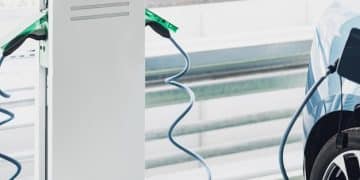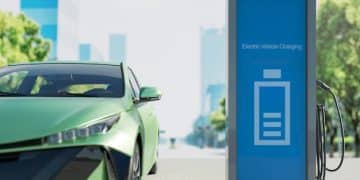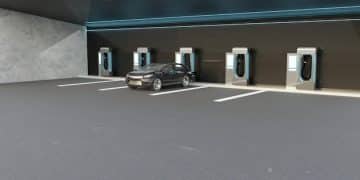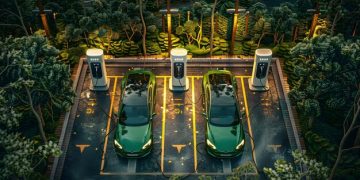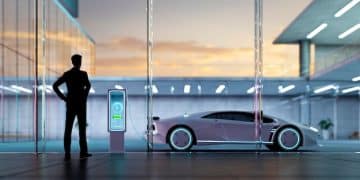Expansion of fast-charging networks for evs: why it matters
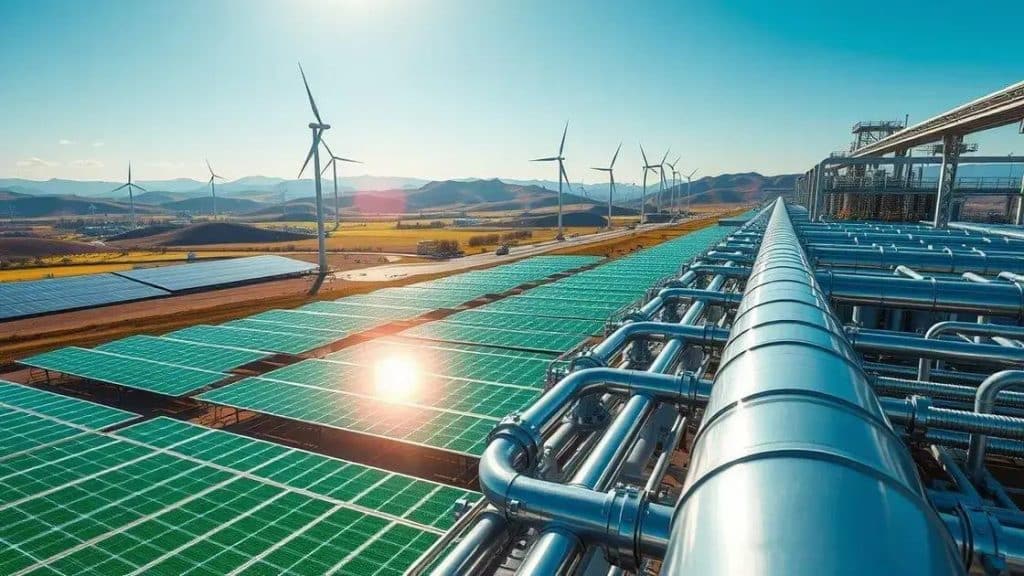
The expansion of fast-charging networks for EVs is crucial for increasing accessibility, reducing range anxiety, and supporting the transition to electric vehicles in both urban and rural areas.
Expansion of fast-charging networks for EVs is crucial as more drivers consider making the switch to electric. Wonder how this affects your ability to travel without range anxiety? Let’s explore the ins and outs of this growing trend.
Understanding fast-charging technology
Understanding fast-charging technology is essential for grasping how electric vehicles (EVs) can become a more convenient choice for everyday travel. Fast-charging stations are designed to charge EVs significantly quicker than standard charging options, making them a vital part of modern infrastructure.
What is Fast-Charging Technology?
Fast-charging technology allows electric vehicles to recharge in a fraction of the time compared to traditional methods. This advanced technology utilizes higher power levels, which enables the battery to charge at a faster rate. Most fast chargers can give an EV up to 80% charge in just 30 minutes!
Types of Fast Chargers
There are several types of fast chargers available:
- DC Fast Chargers: These provide rapid charging through direct current, ideal for quick stops.
- Level 3 Chargers: These are commonly found at public charging stations and can charge your vehicle swiftly.
- Ultra-Fast Chargers: These cutting-edge options can supply over 350 kW, charging EVs even faster.
Understanding these types of chargers can help drivers plan their journeys better, ensuring they can find adequate charging stations along their routes. Fast-charging stations are often located near shopping areas, restaurants, or other amenities, allowing drivers to make the most of their wait time.
In addition to speed, fast-charging technology is continually evolving. Manufacturers are investing in smarter chargers that can communicate with the car, optimizing the charging process based on the vehicle’s needs and battery health. This tech not only improves efficiency but also enhances safety, reducing the risk of battery damage.
As electric vehicle adoption grows, the importance of fast-charging technology will only increase. As awareness improves, the demand for these charging solutions will rise, inspiring more infrastructure development across cities.
Key benefits of expanding charging networks
Expanding charging networks presents several key benefits that can significantly impact the adoption of electric vehicles (EVs). A well-developed charging network not only improves accessibility but also enhances user confidence in transitioning to electric.
Accessibility for Users
One primary benefit of expanding charging networks is greater accessibility for EV users. Having more charging stations available enables drivers to travel longer distances without worrying about running out of power. Increased availability helps meet the growing demand as more people opt for electric vehicles.
Environmental Impact
Another critical advantage of expanding these networks is the positive environmental impact. More charging stations mean that EVs can be charged with renewable energy sources, significantly reducing greenhouse gas emissions. It encourages the use of clean energy, which is essential for tackling climate change.
- Reduction in fossil fuel reliance: A robust charging network empowers drivers to choose cleaner energy options.
- Lower carbon emissions: By using EVs charged from renewable sources, we can contribute to cleaner air and healthier communities.
- Promotion of sustainable practices: A comprehensive network fosters an eco-friendly culture among consumers.
Expanding charging networks also boosts local economies. More charging stations mean more foot traffic for nearby businesses, benefiting local shops and amenities. This economic growth can lead to job creation and increased revenue. As businesses flourish, communities thrive.
Furthermore, this expansion aids in reducing the *range anxiety* many potential EV owners face. By providing charging stations at regular intervals, drivers feel secure in their decision to invest in electric vehicles, knowing they can easily find a charger whenever needed.
Current challenges in infrastructure

Current challenges in infrastructure for electric vehicle (EV) charging networks can hinder their widespread adoption. Despite advancements in technology, there are still significant obstacles that need to be addressed to promote growth effectively.
Lack of Charging Stations
One major challenge is the insufficient number of charging stations, especially in rural areas. Many drivers feel hesitant to purchase electric vehicles due to the fear of running out of charge without accessible charging points. Expanding the network is crucial to alleviate this concern.
- Rural vs. urban disparity: Urban areas often have more stations, leaving rural communities underserved.
- High demand outpacing supply: As EV sales increase, the current infrastructure struggles to keep up.
- Location of chargers: Inefficient placement of stations can lead to long waiting times for users.
Another significant barrier is the varied charging speeds. Not all charging stations offer fast-charging options. This inconsistency can frustrate drivers who need quick recharges during long trips. Transitioning to higher-capacity chargers will be key in solving this issue.
Connectivity and Technology
Connectivity is also a pressing challenge. Many charging stations rely on outdated technology, which can limit their functionality. Furthermore, issues like poor mobile signal can interfere with charging apps that help locate stations. Improving technology and ensuring seamless connections will enhance user experience.
A lack of collaboration between governments, private companies, and charging network providers further complicates infrastructure development. Without a unified strategy, resources may be wasted, and progress could stall. To overcome these challenges, all stakeholders must work together to create synergy for the expansion of charging networks.
Future trends in EV charging
Future trends in EV charging are promising and could significantly change how we think about electric vehicles (EVs). As technology evolves, so does the potential for how we charge these vehicles.
Wireless Charging Technology
One exciting trend is the development of wireless charging technology. This advancement allows EVs to charge without needing cables! With inductive charging pads placed in parking spots, drivers can simply park over them. This method not only simplifies charging but also helps in maintaining battery health.
Smart Charging Solutions
Smart charging is another area poised for growth. These chargers can communicate with the vehicle and optimize the charging process based on energy prices and grid demand. This means drivers can charge their vehicles when it’s cheapest, ultimately saving money.
- Energy management: Smart chargers can manage energy distribution to prevent overloading the grid.
- Integration with renewable energy: They can utilize solar or wind energy, making EV charging cleaner and more sustainable.
- Enhanced user experience: Apps can notify users when charges are complete or when their vehicle needs charging.
Furthermore, the rise of fast-charging infrastructures is expected to continue. These stations will be placed in strategic locations to reduce waiting times and ensure that drivers can quickly recharge on the go. This trend will encourage more people to switch to EVs.
Lastly, we can anticipate increased government support for charging networks. Incentives for companies to install more charging stations will likely grow, resulting in wider access for all drivers. Partnerships between government and private sectors can help accelerate the expansion of EV charging infrastructure.
How cities can support growth
How cities can support growth in electric vehicle (EV) charging networks is a crucial question for sustainable transportation. By implementing effective strategies, urban areas can become pivotal in promoting EV usage.
Building Infrastructure
Cities can begin by investing in the necessary infrastructure. This includes placing charging stations in convenient locations. Streets, parking garages, and shopping centers are excellent spots for chargers. Increasing the number of charging stations reduces range anxiety and encourages more drivers to switch to electric vehicles.
Incentives for Businesses
Another strategy is to provide incentives for local businesses to install charging stations. Grants or tax breaks can motivate companies to invest in EV infrastructure. This not only helps the businesses increase traffic but also fosters a community-friendly environment.
- Partnerships with charging network providers: Collaborating with companies that specialize in EV charging can enhance growth opportunities.
- Support for renewable energy: Cities can promote the use of solar panels at charging stations, making the energy cleaner and more sustainable.
- Education and outreach programs: Informing citizens about the benefits of EVs and charging options can increase awareness and user adoption.
Public transportation systems can also integrate EVs. By adding electric buses and shuttles, cities can set an example for sustainability. Providing charging stations for these vehicles can further support EV growth in the community.
Policies promoting eco-friendly practices play a vital role. Cities can adopt regulations that encourage developers to include EV charging stations in new construction projects. This can ensure that the necessary infrastructure is in place as electric vehicle adoption increases.
FAQ – Frequently Asked Questions about Fast-Charging Networks for EVs
What are fast-charging networks?
Fast-charging networks consist of stations that provide electric vehicles with quicker charging options, drastically reducing the time it takes to recharge compared to standard charging.
How can cities support the growth of these networks?
Cities can invest in infrastructure, offer incentives for businesses to install chargers, and promote public awareness about the benefits of electric vehicles.
What are the benefits of expanding EV charging stations?
Expanding charging stations increases accessibility, reduces range anxiety for drivers, and supports the growth of electric vehicle adoption.
What challenges does the current infrastructure face?
Challenges include a lack of charging stations in rural areas, varied charging speeds, and outdated technology at existing stations.
